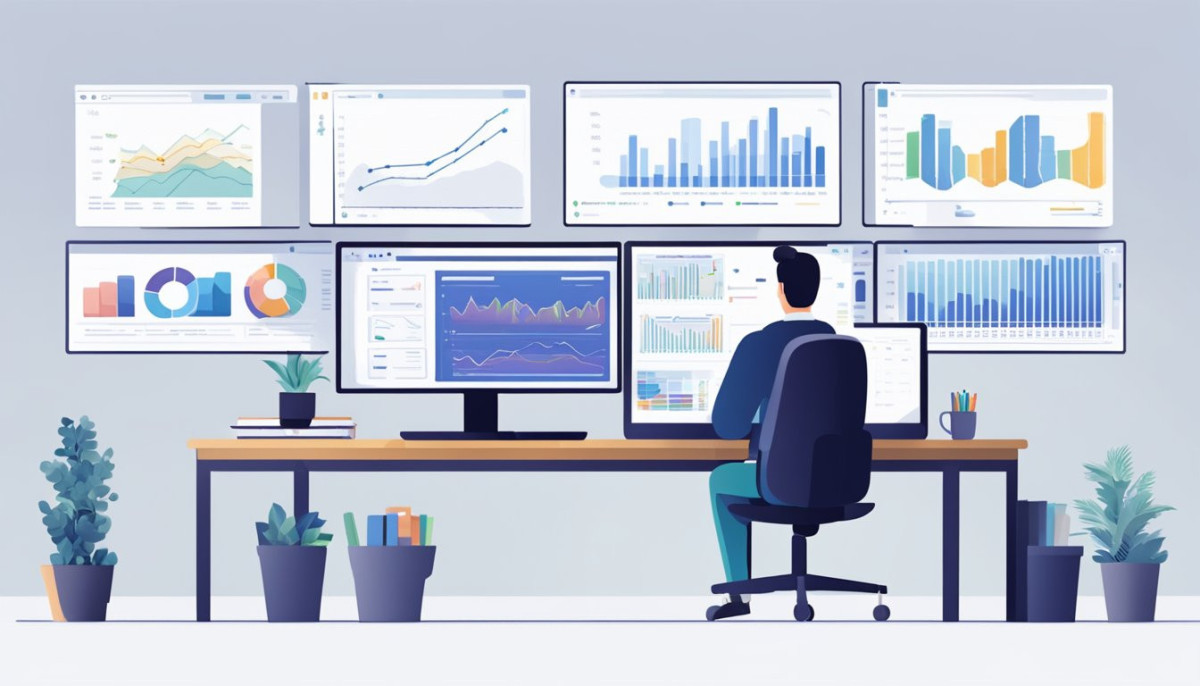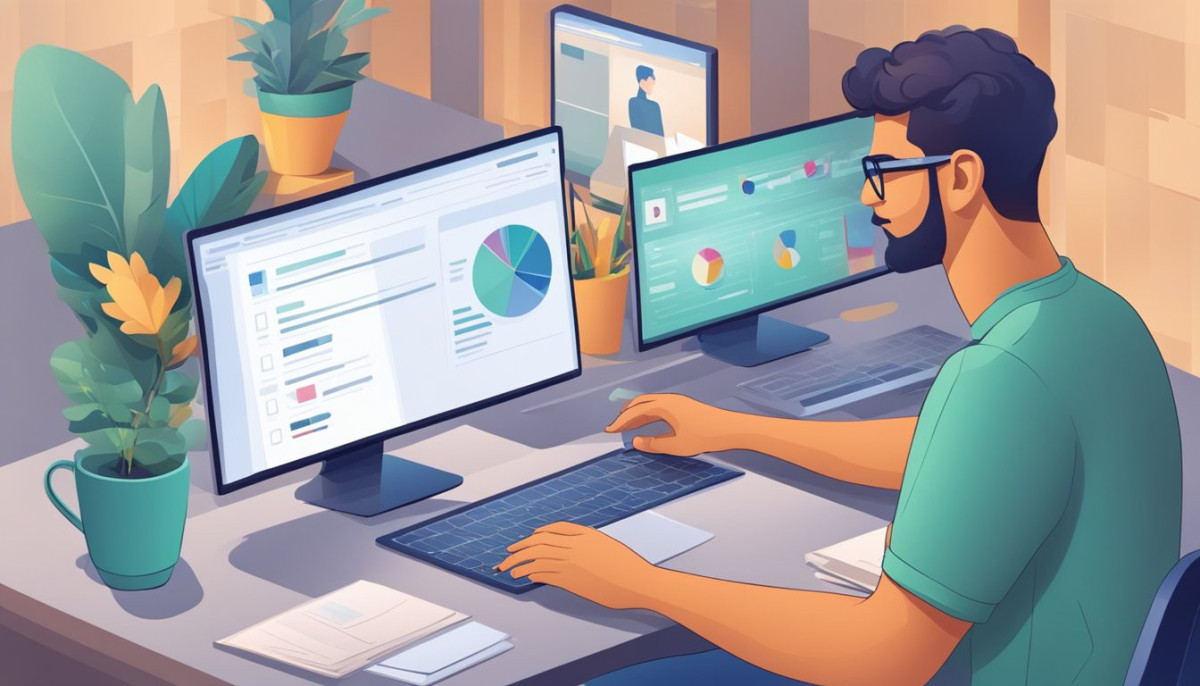- Research platform
Sources of information
Data analysis
Actions
- Solutions
For whom
Problems / Issues
- Materials
Materials
- About us
About us
Have you ever wondered how online research platforms can support traditional customer research methods? Despite the development of modern technologies, research of stationary sales channels has not lost its importance; on the contrary, it can now be carried out even more effectively. In this article, we will show you how to effectively survey retail customers using online tools to collect, analyze and integrate data from various sources.

Offline research via online platforms enriches the understanding of consumer behavior.
Combining offline methods with online analysis enables comprehensive data.
Research platforms effectively support management and implementation of results from desktop channel research.
In the context of market research, we often focus on web analytics and online research, forgetting the rich information that comes from direct contact with consumers. Researching stationary sales and contact channels allows us to capture subtleties that may be missed in the digital world. By going beyond the screens of our devices, we are able to better understand these aspects and consumer needs.
After all, not every meaningful interaction with a brand takes place online - many take place in stores, at events or in everyday situations that can be crucial to getting to know customers.

The use of traditional methods makes it possible to obtain reliable data, which is the foundation for strategic decision-making.
Surveys and paper questionnaires are some of the most classic research tools that are used in fixed-point research. Their main advantage is the ability to reach respondents directly, making it possible to collect rich qualitative and quantitative data. They are particularly useful in places where internet access is limited, among demographic groups less familiar with digital technology, or in situations where it is necessary to reach groups that cannot be digitally stargeted.
One-on-one interviews are a qualitative research method that involves a direct, often in-depth conversation with the respondent. They provide detailed information about a person's experiences, beliefs, attitudes and motivations. Unlike surveys, one-on-one interviews give researchers the opportunity to ask open-ended questions and conduct the conversation in a way that can uncover new ideas and perspectives that would not be revealed in a more structured research format.
Focus groups, on the other hand, are a type of qualitative research in which a group of people - usually 6 to 10 participants - are led by a moderator in a discussion on a specific topic. This format allows observation of group dynamics and interactions among participants, which can lead to a deeper understanding of their attitudes and behavior. Focus groups are particularly useful when you want to understand reactions to a new product, service or concept, and when you are interested in differences in opinion between different segments of the population under study.
Using one-on-one interviews and focus groups, researchers can adjust questions on the fly, responding to participant responses, allowing for a deeper understanding of the topic under study. This is particularly important in cases where the scope of the study involves complex or sensitive issues, where flexibility and adaptability to respondents' reactions are key to obtaining reliable results.
Monitoring customer behavior in natural settings, such as in stores, to understand their natural buying behavior. Observation allows for non-invasive analysis of respondents' behavior in their natural environment. For example, monitoring customers in a store can provide information about the ways in which they make purchasing decisions, i.e. the most popular aisles of the market or products within sight of respondents.
A popular research technique used mainly to assess the quality of customer service, compliance with company standards, and verification of the shopping experience. It is a form of offline survey in which people hired by a research company or directly by a company visit a retail outlet, restaurant, bank or other service facility, posing as ordinary customers. The goal is to gather detailed information about their experience without revealing their true identity to the staff of the place being surveyed.
Usability testing, also known as usability testing, is a research method that allows real users to evaluate products or services under controlled conditions. The goal is to gain information about usability, intuitiveness of the interface and overall satisfaction with the experience. Testing observes how users perform tasks, identifies potential problems and collects feedback that is invaluable in improving products and increasing customer satisfaction.
Usability testing can take a variety of forms, from individual sessions in which a participant performs a series of tasks, to more complex group studies where product functionality is discussed. During testing, researchers often use techniques such as eye tracking, or tracking eye movement, to understand what users are paying attention to, as well as tools to record interactions with the system for later detailed analysis.
Each of these methods has its own unique uses and advantages, and the tools used vary depending on needs.

Developments in technology have influenced offline data collection methods, introducing modern solutions that facilitate the process. Each of the methods described below offers unique perspectives on customer behavior and allows data collection in different contexts.
Direct data collection methods, such as digital kiosks and QR codes, allow for quick and interactive communication with customers. The use of mobile devices allows the collection of data on the spot and its immediate transfer to analytics platforms, which speeds up the entire research process. In addition, it is important to pay attention to the security and privacy of the information when collecting offline data, in accordance with the provisions of the DPA.
Indirect data collection methods, such as transactional data analysis, offer valuable insights into customer behavior without direct contact. This data, including declarative data, allows predicting future behavior and adjusting marketing activities to better respond to customer preferences and needs.
Combining research methods provides a more comprehensive picture of customer preferences and behavior. This is particularly important in areas where internet access is limited or customer preferences are more diverse.
"Click and Collect" research focuses on analyzing customer satisfaction and experience with online shopping and point-of-sale pickup. This is an interesting case of research in that you can hook into both areas - online and in-store - at the same time.
Loyalty program research allows you to analyze the experience of engaged customers. Through the study of loyalty programs, it is possible to gain insight into the behavior and preferences of the most engaged customers, which allows you to better understand their needs in the context of stationary shopping.
Research based on QR codes makes it possible to reach non-buyers or those reluctant to use a loyalty program. Using QR codes as a tool in research allows you to reach potential customers who have not yet made a purchase, but may be interested in the offer.
Ratings and reviews from Google Maps. Reviews from Google Maps are a valuable source of information on how customers perceive the location, quality of service and their overall satisfaction related to visiting a location. It is also worth considering monitoring competitors to know how business-relevant areas are rated.

When embarking on offline research, it is important to consider a number of weaknesses and challenges it may present. Properly structuring traditional research requires an analysis of the potential constraints that may affect its conduct and final results.
Costs: Offline surveys typically involve higher costs compared to surveys conducted online. These costs increase significantly with an increase in the number of participants and the scope of the survey.
Scalability: Reaching a large number of respondents in offline surveys is more complicated and requires additional labor and additional people compared to extensive online research platforms.
Time-consuming: From the planning phase to data collection to results analysis, offline surveys tend to be more time-consuming than their online counterparts, which can delay business decisions.
Logistical complexity: Each stage of an offline survey requires both more organizational effort and more physical resources, including space for interviews or focus groups.
Subjectivity of data: Data can be subjective and dependent on interviewers' individual experiences.
Using tools to digitize and analyze responses from paper surveys and online feedback is key. Companies often use scanning and OCR (Optical Character Recognition) to convert information from paper surveys into digital form. Then, with the help of sophisticated analytics software, the data is analyzed and interpreted to provide valuable insights for the company.
Integrating offline surveys with online surveys is key to obtaining comprehensive and multidimensional data. Combining traditional methods with modern analytical tools allows for a more complete understanding of consumer behavior. For example, data from online desktop point-of-sale surveys can be supplemented with information obtained from tools that track user behavior on websites, providing the opportunity to compare declarations with actual actions. In addition, analysis of data obtained from social media can enrich offline survey results with emotional aspects and opinions expressed in the online space. Using technologies such as artificial intelligence and machine learning, researchers can integrate and analyze large data sets from different sources, which contributes to a deeper understanding of customer needs and expectations.
Paying attention to the representativeness of the sample and the reliability of the research tools is key. Recruitment of participants should be done in a controlled manner, and the tools used must be reliable for the data to be useful.

The following section presents reliable examples of offline research application using online research platforms. Each case is from a different industry and illustrates how companies are improving their services and processes by relying on specific research.
A company in the construction and renovation industry conducted research on its "Click and Collect" service to understand the experience of its customers. Based on online surveys that consumers filled out after picking up goods, the company identified and removed the most common obstacles in the pickup process (such as the lack of additional signage at the pickup point), significantly affecting customer satisfaction and loyalty.
Using QR codes placed in waiting areas, the airport solicited passengers' opinions on their experiences with departure wait times. The data helped to streamline queuing arrangements and improve the traveler experience.
The restaurant conducted an in-depth analysis of comments from Google Maps Reviews, and based on this, made changes to the menu and improved the standard of service. These measures led to increased customer satisfaction and positive reviews which resulted in more visitors to the establishment.

Once the survey has been conducted, the key is to use the collected data effectively. The two main steps are to develop an implementation strategy for the results and to continuously monitor their impact on the business.
Implementation strategies should be tailored to the specifics of the organization and the results obtained from offline surveys. For example, if the results of a customer satisfaction survey conducted at a stationary store indicate a need to improve the service process, specific changes in customer flow or speed of service should be considered. Implementation may require prioritizing tasks according to their relevance and potential added value for customers and the company.
Once changes have been implemented, it is important to conduct ongoing monitoring of their effects. This should include both analysis of sales data and feedback from customers (both offline and online). Monitoring allows you to quickly identify areas that effectively meet consumer needs and those that need further modification.
Offline research plays an irreplaceable role in deep understanding of customers and their behavior. Direct research methods such as paper surveys, personal interviews, focus groups and observations provide valuable information that online research may miss. Using online platforms to analyze and integrate offline survey data allows for effective management of results and their rapid implementation in development strategies.
Data obtained from offline surveys can be effectively analyzed using online research tools. They allow you to process and interpret the acquired information, such as surveys and interviews, using advanced data analysis software (e.g. automatically categorizing customer statements or combining different research sources).
The main differences between online research and traditional offline research relate to data collection methods, scale and speed. Online surveys often reach a wider group of respondents in a shorter period of time, while traditional methods offer direct contact and can be more detailed in terms of qualitative information collection.
Copyright © 2023. YourCX. All rights reserved — Design by Proformat